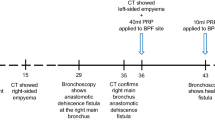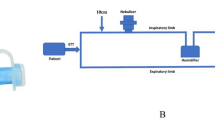Abstract
We report the case of a 5-year-old boy who developed chronic plastic bronchitis after Fontan surgery for a complex congenital heart disease. During a new admission for acute exacerbation of plastic bronchitis, he started on a mucolytic treatment with inhaled rhDNAse instead of inhaled fibrinolytics because of the potential bleeding risk in a patient on combined coumarin and aspirin treatment. Respiratory symptoms resolved promptly, and the patient was discharged home on rhDNAse treatment. He remained clinically stable on rhDNAse treatment without further hospitalization until definitive treatment with dynamic lymphangiography and percutaneous embolization.
Similar content being viewed by others
Avoid common mistakes on your manuscript.
A 5-year-old boy with a past medial history of Fontan surgery for a complex congenital heart disease (CHD) presented with paroxysmal cough, spontaneous expectoration of large bronchial casts (Fig. 1), and respiratory distress. He was diagnosed with plastic bronchitis (PB) and admitted to the hospital. He was started on a mucolytic treatment with inhaled rhDNAse instead of inhaled fibrinolytics because of the potential bleeding risk in a patient on combined coumarin and aspirin treatment. Respiratory symptoms resolved promptly, and the patient was discharged home on rhDNAse treatment. He remained clinically stable on rhDNAse treatment without further hospitalization. Five months after discharge, he underwent dynamic contrast lymphangiography that demonstrated abnormal pulmonary lymphatic flow followed by successful partial thoracic duct embolization.
PB is a rare condition characterized by thick, mucofibrinous plugs that occlude the airway. Although PB has been associated with different respiratory disorders, it can occur after Fontan surgery in patients with CHD [1]. PB classification is based on both the associated disease and cast histology [2, 3].
Given the unclear pathogenesis of PB, treatment regimens are based on case reports and include inhaled or systemic corticosteroids, aerosolized acetylcysteine, tPA, and rhDNAse [4]. However, none has proven effective for all patients. We undertook a preliminary experiment to determine cast composition and its responsiveness to fibrinolytic and mucolytic treatments ex vivo. Spontaneously expectorated PB casts were obtained from our patient before and after rhDNAse treatment and exposed ex vivo to NaCl 0.9%, tPA, sodium bicarbonate and rhDNAse at 37 °C. Microscopically, the cast was composed of fibrin intermingled with inflammatory cells (Fig. 2). After 72 h incubation we observed complete dissolution of the cast incubated with rhDNAse as compared to all other treatment modalities (Fig. 3 a, b). Interestingly casts collected after 2 weeks of rhDNAse treatment, were almost completely dissolved after 72 h with all treatment modalities (Fig. 3c, d). It has been suggested that rhDNase improved mucociliary clearance not only by the hydrolysis of extracellular DNA but also by altering the physical and rheological of sputum independent of its DNA content [5].
a, b Prior to rhDNAse treatment, the cast were composed of fibrinous and mucinous material admixed with inflammatory cells consisting of numerous lymphocytes, together with neutrophils, macrophages, and few eosinophils (Hematoxylin and Eosin, H&E, original magnification ×100 and ×400). c, d After rhDNAse treatment, fibrin and mucous was intermingled with aggregates of macrophages (c, H&E ×100), or with neutrophils, with fewer lymphocytes, and no eosinophils (d, ×400)
a Casts before incubation with NaCl 0.9%, tPA, sodium bicarbonate, and rhDNAse at 37 °C. b Casts after 72 h of incubation with NaCl 0.9%, tPA, sodium bicarbonate, and rhDNAse at 37 °C. c New casts collected after 2 weeks of rhDNAse nebulization and before incubation with NaCl 0.9%, tPA, sodium bicarbonate, and rhDNAse at 37 °C. d Casts after 72 h of incubation with NaCl 0.9%, tPA, sodium bicarbonate, and rhDNAse at 37 °C
In conclusion, rhDNAse may be an effective treatment option during acute PB exacerbation by facilitation bronchial casts expectoration until definitive treatment by dynamic lymphangiography and thoracic duct embolization.
References
Healy F, Hanna BD, Zinman R (2012) Pulmonary complications of congenital heart disease. Paediatr Respir Rev 13(1):10–15. https://doi.org/10.1016/j.prrv.2011.01.007
Seear M, Hui H, Magee F, Bohn D, Cutz E (1997) Bronchial casts in children: a proposed classification based on nine cases and a review of the literature. Am J Respir Crit Care Med 155(1):364–370. https://doi.org/10.1164/ajrccm.155.1.9001337
Madsen P, Shah SA, Rubin BK (2005) Plastic bronchitis: new insights and a classification scheme. Paediatr Respir Rev 6(4):292–300. https://doi.org/10.1016/j.prrv.2005.09.001
Brooks K, Caruthers RL, Schumacher KR, Stringer KA (2013) Pharmacotherapy challenges of Fontan-associated plastic bronchitis: a rare pediatric disease. Pharmacotherapy 33(9):922–934. https://doi.org/10.1002/phar.1290
Puchelle E, Zahm JM, de Bentzmann S, Grosskopf C, Shak S, Mougel D, Polu JM (1996) Effects of rhDNase on purulent airway secretions in chronic bronchitis. Eur Respir J 9(4):765–769. https://doi.org/10.1183/09031936.96.09040769
Author information
Authors and Affiliations
Corresponding author
Ethics declarations
Conflict of interest
All the authors declare no conflict of interest and no relationship with industry. All the authors disclose any prior presentation of study as an abstract or poster.
Ethical Approval
This is a case report with no personally identifiable information included in the report.
Informed Consent
Informed consent was obtained from the patient’s legal guardians.
Additional information
Publisher's Note
Springer Nature remains neutral with regard to jurisdictional claims in published maps and institutional affiliations.
Rights and permissions
About this article
Cite this article
Grazioli, S., Rougemont, AL. & Ruchonnet-Métrailler, I. Human Deoxyribonuclease (rhDNase) Nebulization as an Alternative Treatment for Refractory Plastic Bronchitis After Fontan Surgery. Pediatr Cardiol 41, 1071–1073 (2020). https://doi.org/10.1007/s00246-020-02368-1
Received:
Accepted:
Published:
Issue Date:
DOI: https://doi.org/10.1007/s00246-020-02368-1







